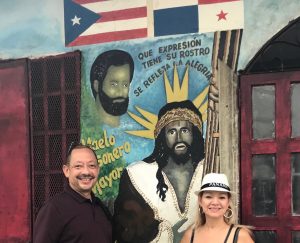This post is also available in:
 Español
Español
In 1969 Sorolo went to a public concert in Panama, and the events that unfolded can be described as miracles that transformed his life and the life of Ismael Rivera as well.
On that fateful night, Sorolo would meet Ismael Rivera for the first time and a day later introduce him to the Cristo Negro in Portobelo. That was the event that led Ismael to quit drugs!
The Miracles
It turns out that as Sorolo approached the concert venue that night, he heard a voice…
“Find Ismael Rivera and introduce him to me”, Sorolo recounted with tears forming in his eyes as he made a cross with the index and thumb fingers of his right hand, and kissed it.
“I swear to God”, he added.
I will consider this as the first miracle!

But how would he meet Ismael Rivera? He didn’t know him, and Ismael could well be out of reach surrounded by a million people.
So as Sorolo tells us, after the concert he started walking towards the back of the stage. He figured that would give him the best chance to find Maelo among the thousands of people there.
By serendipity (was it really?), he found a musician friend of his, who immediately told him…
“Hi Sorolo, come with me, I’ll introduce you to Ismael Rivera”. Sorolo had not told him (or anyone else) anything about the voice he had heard earlier.
When Sorolo was introduced to Ismael, Maelo stared at him for a while, like if he knew him from somewhere but was trying to remember from where. After what seemed a long moment, he asked him if he had any drugs. Sorolo didn’t even know what “tecata” (slang for heroin) meant; at least not by that name.
“No, I don’t”, he replied, because he didn’t use drugs.
Sorolo noticed that Ismael Rivera was in bad shape. He seemed not able to stand straight and had this sad and gleamy look in his eyes. As if he were completely out of energy. Sorolo gathered some courage and told Ismael…
“Here [in Panama] we have a ‘Cristo Negro milagroso’; you need to come with me to Portobelo to see him”.
Sorolo, Ismael Rivera go to Portobelo
The proposal worked!
It so happened (another coincidence?) that Ismael was to play in Colon the next day. Colon is a city on the Atlantic coast, not far from Portobelo.
So the next day (Sunday), they went to Portobelo to the Church of San Felipe. Rafael Cortijo, who was in Panama for the concert, went along with them.

When Maelo saw the Cristo Negro, he immediately fell on his knees, put his face close to the floor, and began crying uncontrollably. He stayed in that position for a long while.
The next day, when Sorolo went to see Ismael, he found him at the lobby of the hotel in Colon with his musicians and with Cortijo. Ismael excused himself from the group and took Cortijo and Sorolo to his room. There, on top of a small table, there were drugs and some accessories to use it. Ismael wrapped them up and gave them to Sorolo with the following instructions…
“Here, take these and throw them away. Your brother is no longer a drug user.”
That was a very emotional moment! Sorolo’s friendship with Ismael Rivera was cemented that day. Maelo would keep calling Sorolo his “brother” until his death.
Sorolo affirms that Ismael Rivera did quit drugs (at least heroin) that day in Panama.
I think it’s fair to consider this as another miracle!
The Song of “El Nazareno“
The famous song of “El Nazareno” would come out in 1974, or about 5 years after these events.
Sorolo knew that Henry Williams wrote the song for Ismael. However, it was Ismael who made the song a homage to the Cristo Negro in his “soneos”. The song Williams wrote references Jesus, but not the Cristo Negro in particular. It was Ismael, with his transformative experience, who did this with his singing.
Three years later, Ismael Rivera would do the same thing with the song “El Mesias”. This song was part of his 1977 album “De Todas Manera Rosas”. In this song, written for him by Puerto Rican songwriter Johnny Ortiz, Ismael also dedicates the song to the Cristo Negro and the people of Panama.
“Que lindo mi Nazareno,
..que lindo mi Nazareno,
..el 21 de octubre, Panameño nos veremos,
..y cargaremos…”
These words from a “soneo” in “El Mesias” would be engraved in a statue in Portobelo honoring Ismael Rivera. By the way, that statue has the head of Sorolo engraved in the chest of Ismael.
And to complete the cycle of Ismael Rivera religious songs, the first one, before “El Mesias” and before “El Nazareno”, was “San Miguel Arcangel”. Maelo included this song, also written by Henry Williams, in his 1972 album “Esto Fue Lo Que Trajo el Barco”.
In this song, Ismael makes only one small mention of El Nazareno when he sings…
“Con Yemayá Belen va con Eleguá y Changó,
..te digo ese negrito lo cortejo yo”
But it was “El Nazareno” the song in which he would pour his heart into. He did it as a way to thank Christ for his recovery.
Many say that Ismael Rivera’s recovery after meeting the Cristo Negro not only saved his musical career but also saved his life.


Great Article!
Hector, How come so little is known about the Author, Henry D Williams? Who is he? where does he come from?
Piero, I’m glad you enjoyed the article.
Good question on Henry Williams. I might look into that for a future blog.
Best,
Hector
[…] Reyes Magos knew that the Nazareno had been born, and they decided to go to see and worship him and bring him gifts. In other words, […]
[…] Reyes Magos knew that the Nazareno had been born, and they decided to go to see and worship him and bring him gifts. In other words, […]
[…] crowd, which enjoyed listening and dancing to their music. The band also paid tribute to Ismael Rivera, the legendary salsa singer who was born in Santurce. With Rafael Cortijo, Ismael helped revitalize […]